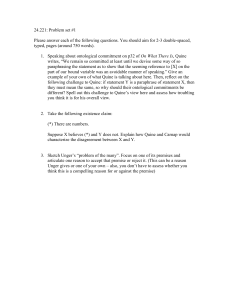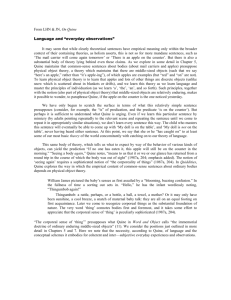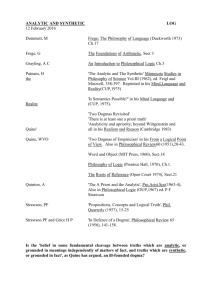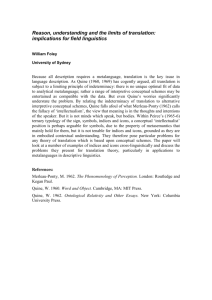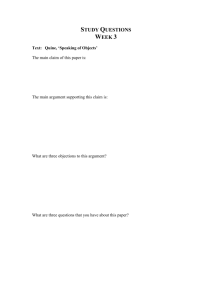Document 13520071
advertisement
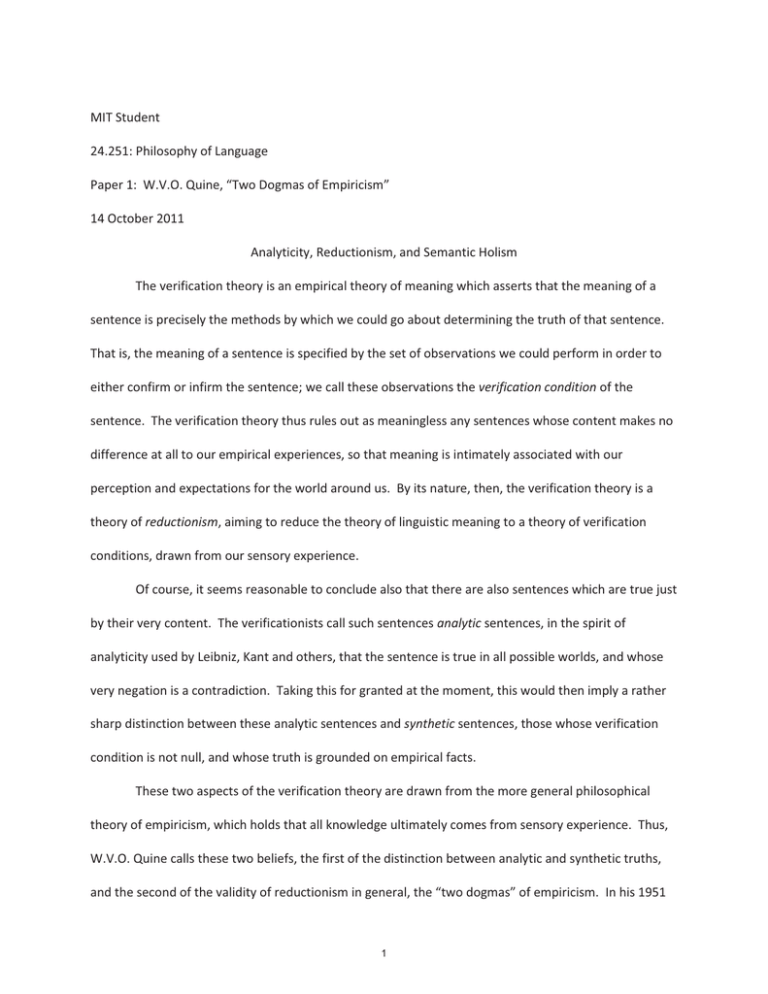
24.251: Philosophy of Language Paper 1: W.V.O. Quine, “Two Dogmas of Empiricism” 14 October 2011 Analyticity, Reductionism, and Semantic Holism The verification theory is an empirical theory of meaning which asserts that the meaning of a sentence is precisely the methods by which we could go about determining the truth of that sentence. That is, the meaning of a sentence is specified by the set of observations we could perform in order to either confirm or infirm the sentence; we call these observations the verification condition of the sentence. The verification theory thus rules out as meaningless any sentences whose content makes no difference at all to our empirical experiences, so that meaning is intimately associated with our perception and expectations for the world around us. By its nature, then, the verification theory is a theory of reductionism, aiming to reduce the theory of linguistic meaning to a theory of verification conditions, drawn from our sensory experience. Of course, it seems reasonable to conclude also that there are also sentences which are true just by their very content. The verificationists call such sentences analytic sentences, in the spirit of analyticity used by Leibniz, Kant and others, that the sentence is true in all possible worlds, and whose very negation is a contradiction. Taking this for granted at the moment, this would then imply a rather sharp distinction between these analytic sentences and synthetic sentences, those whose verification condition is not null, and whose truth is grounded on empirical facts. These two aspects of the verification theory are drawn from the more general philosophical theory of empiricism, which holds that all knowledge ultimately comes from sensory experience. Thus, W.V.O. Quine calls these two beliefs, the first of the distinction between analytic and synthetic truths, and the second of the validity of reductionism in general, the “two dogmas” of empiricism. In his 1951 paper “Two Dogmas of Empiricism,” Quine attacks both of these dogmas, first questioning the distinction between analytic and synthetic truths, and then moving on to cast doubt on the feasibility of reductionism in the philosophy of language. He argues that, in fact, the first dogma is not independent of the second, and, more pointedly, the only way to save the first is to assume the second. Thus, by rejecting reductionism on a sentence-by-sentence basis (the second dogma) as untenable, he concludes that the only way to preserve empiricism itself is to turn to a more holistic approach for meaning, wherein the meaning of sentences cannot be understood nor even considered individually, but rather in terms of the entire language as a whole. Quine spends a great deal of his paper arguing for the dependence of analyticity on that of verificationist reductionism. To accomplish this, Quine considers a number of ways by which we could define analyticity separately from verification—he considers definition, interchangeability, and even the use of sematical rules. We discuss two of these, definition and interchangeability, in brief, to get a flavor of Quine’s argument. The essence, however, is that any attempt to nail down the analyticity of a sentence in the end seems to double back to the concept of analyticity itself, in “the form, figuratively speaking, of a closed curve in space,” as he describes it. To take his example, a sentence like “No bachelor is married,” is a typical example of what the verificationists would call an analytic truth. But Quine notes that this requires the concept of synonymy—we need to first substitute “unmarried man” for “bachelor” in order to obtain the logical truth “No unmarried man is married.” But how do we go about finding out this synonymy? Quine argues that this is a difficult problem. The obvious attempt at using the idea of definition fails because it simply is not the case that people sat down at some point in history and defined “bachelor” to be “unmarried man.” The only case in which definition is sufficient for synonymy is when a word has been chosen specifically to be shorthand for a longer phrase; unfortunately, this is not how most language works. To attempt to define “bachelor” we must appeal to other synonyms to eventually arrive at “unmarried man.” But then synonymy is just as difficult as analyticity. Another attempt Quine consider is the use of interchangeability salva veritate, where interchanging the word “unmarried man” for “bachelor” does not cause the truth-value of the sentence change. It certainly does seem possible to use this approach, since the statement “Necessarily, all and only bachelors are unmarried men,” has the same truth condition as “Necessarily, all and only bachelors are bachelors.” But the problem lies in the use of the word “necessarily,” which Quine argues is a feature of our language that presupposes an independent understanding of analyticity. Without the use of “necessarily,” as in an extensional language, we lose the kind of synonymy we are looking for; interchanging “a creature with a heart” with “a creature with kidneys” preserves the truth-value of any sentence containing the phrase “a creature with a heart,” but this accidental matter of fact does not have the same kind of status as seemingly more direct synonymy as with “bachelor” and “unmarried man.” Thus, since the only way to use interchangeability is to assume we have precisely what we are looking for, Quine rejects this attempt at a solution as well. Once Quine establishes the difficulty of determining the analyticity of a sentence independently of the verificationist criterion, he then turns to verification as the only source of hope. In this program, Quine notices that we can define an analytic sentence as precisely those sentences whose verification condition is null—that is, sentences which do not require any empirical observation to establish their truth. Thus, we can simply define analyticity in terms of verification, and have the first dogma of empiricism depend on the second. As Quine puts it, “if the verification theory can be accepted as an adequate account of statement synonymy, the notion of analyticity is saved after all.” This is a big gamble, as the collapse of the second dogma will inevitably drag the first with it as well, but Quine is left with no alternatives after the apparently hopeless attempts in nailing down analyticity independently. And of course, this collapse, Quine pursues, is precisely what happens. Quine interprets the second dogma to be the claim that the meaning of a single, individual sentence is just the verification condition of that sentence—that associated with each (synthetic) sentence is a set of empirical observations which could be done in order to verify the truth of the sentence. But Quine questions whether this could actually be done. To accomplish this kind of reduction, there must be some way of translating a sentence to a “sense-datum language” of purely sensory data, so that we can associate each meaningful sentence with a statement about immediate experience. The problem is that it is very difficult to do so for single sentences. Given a hypothesis, it is not, in general, possible to verify that hypothesis without any additional assumptions. Lycan in Chapter 8 gives an illuminating example, of the statement “There is a chair at the head of this table.” The observation statement of this sentence could be that there is an object with four legs and a seat located near another object with a flat top, and so on, but this presupposes that we can trust our eyes to tell us what is in the room. Other concerns might be whether our eyes are open, the room is lighted, the chair is in plain view, we are not hallucinating, etc. The point is that verifying a sentence involves a set of observation statements which directly involve other sentences, ones which we have no desire to consider. But consider them we must, or else we cannot uphold the program of verification. It appears then that both dogmas of empiricism have come down on this problem of the complexity of verification. But instead of rejecting empiricism because of this, Quine bites the bullet and suggests that perhaps we could embrace the difficulty of verification. That is, if we accept that statements confront empirical verification along with a mass of other statements, then we can still hold onto the theory of empiricism at, at least, the spirit of verificationism. We no longer have reductionism on single sentences standing on their own, nor can we maintain a sharp distinction between analytic and synthetic sentences. But, Quine argues, the downfall of these two dogmas leads instead to a holistic approach to empiricism in the theory of meaning which has implications for the philosophy of both language and science. Quine urges for empiricism without the two dogmas, or in his words, a theory of meaning where “our statements about the external world face the tribunal of sense experience not individually but only as a corporate body.” Reductionism in the sense of the second dogma thus becomes impossible, and without that, it is consequently difficult to define a sharp distinction between analytic and synthetic truth, for “any statement can be held true come what may, if we make drastic enough adjustments elsewhere in the system” of all our statements about the world. Thus, the meaning of language becomes as inextricably tied up as our beliefs about the world, and the best we can do from an empirical standpoint is to compare the meaning of our sentences in the context of all our other sentences to the external world; in the same spirit as the verificationists ruled out talk about matters of no difference to our experiences, Quine states, “it is nonsense, and the root of much nonsense, to speak of a linguistic component and a factual component in the truth of any individual statement,” which is as much of a death knell to simplistic, radical reductionism as verificationism was to the metaphysics before it. More interestingly, Quine in fact widens the scope of his new take on empiricism to involve much more than just the philosophy of language. He describes the very structure of our beliefs and knowledge about the world as “a man-made fabric which impinges on experience only along the edges…total science is like a field of force whose boundary conditions are experience. A conflict with experience at the periphery occasions readjustments in the interior of the field.” Thus, the great collection of our sentence and our beliefs are only connected to experience via a network of many others, and when we meet a conflict with experience, we can pick any of the nodes in the network to tweak. The converse to this is that there are “no statements immune to revision,” as Quine gives the example of the rejection of the law of the excluded middle in the face of quantum mechanics. It is not the case that we merely have a single sentence or belief which is either falsified or verified. Rather, we need to consider all the possible contingencies of which our statement and the sense-datum are functions. It then is up to the individual to determine which of these contingencies might be worth falsifying or verifying, or whether they all hold together, and it is in fact the sentence which the empirical verdict falls upon. This is, in some sense, a reformulation of the spirit of pragmatism, only elevated beyond the scope of an individual belief or thought to a sort of pragmatism on the whole of our knowledge and beliefs. Quine remains a steadfast empiricist, but in his view, the limited dogmas, though tidy and satisfyingly detailed in their treatment of individual beliefs and statements, cannot hold up against the very nature of empiricism, and especially against the complicated and interdependent ways by which we gain experiential knowledge. Quine put questions about the meaning of sentences on par with questions about our knowledge of the world, and he maintains that this duality prevents us from saying whether a difference in meaning is a difference in words or a difference in fact. Either way a difference is a difference, but this time, it is up to us to pick out the distinction for ourselves, in a manner not quite unlike the pursuit of natural science. 0,72SHQ&RXUVH:DUH KWWSRFZPLWHGX ,QWURGXFWLRQWR3KLORVRSK\RI/DQJXDJH )DOO )RULQIRUPDWLRQDERXWFLWLQJWKHVHPDWHULDOVRURXU7HUPVRI8VHYLVLWKWWSRFZPLWHGXWHUPV
